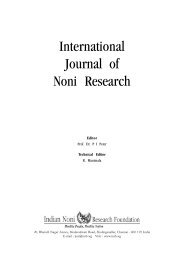International Journal of Noni Research - Noni Family
International Journal of Noni Research - Noni Family
International Journal of Noni Research - Noni Family
Create successful ePaper yourself
Turn your PDF publications into a flip-book with our unique Google optimized e-Paper software.
D.R. Singh et al. Morinda citrifolia L. – An evergreen plant for diversification in commercial horticulture<br />
In sea water irrigation treatment, the plants irrigated with 50% sea water<br />
recorded maximum rate <strong>of</strong> photosynthesis (87.30 µmol/sq m/s), PAR (6.00<br />
µmol/sq m/s), rate <strong>of</strong> transpiration (0.60 µmol /sq m/s) and stomatal<br />
conductance (32.90 µmol/mol) whereas the internal CO 2 content was recorded<br />
to be high (757.90 kPa) in plants irrigated with 100% sea water.<br />
Storage behavior <strong>of</strong> fruits<br />
The storage behavior and the physiological loss in weight <strong>of</strong> fruits exhibited<br />
significant variation with respect to number <strong>of</strong> days stored. With the<br />
advancement <strong>of</strong> days in storage, the percentage reduction <strong>of</strong> fruits gradually<br />
increased over number <strong>of</strong> days stored. It was observed that shelf life <strong>of</strong> fruits<br />
lasted up to 5-7 days in open conditions at room temperature <strong>of</strong> 25 – 30<br />
0 C and Relative humidity <strong>of</strong> 70-75%. The mature fruits tend to change its<br />
color from greenish yellow to creamy yellow from third day onwards whereas<br />
ripe fruits <strong>of</strong> yellowish green color turn to white on fifth day. Regarding<br />
weight <strong>of</strong> mature fruits, 12 –15 g <strong>of</strong> loss in weight was found and about<br />
16-18 g <strong>of</strong> loss in weight <strong>of</strong> ripe fruits was observed.<br />
Economics <strong>of</strong> Morinda cultivation<br />
<strong>Noni</strong> plants start flowering 8-10 months after planting. But it is suggested to<br />
remove all the flowers up to 1.5 to 2 years. This operation ensures better<br />
growth and bushy plant. Flowering and fruiting continues throughout the<br />
year. Commercial harvest starts from 20 to 24 months onwards. It yields 10<br />
kg/plant after 24 months. It is reported that <strong>Noni</strong> plant is capable <strong>of</strong> giving<br />
yield up to 250 - 300 kg/tree under better cultivation condition after 7-8<br />
years. Yield range may be 30 - 40 kg/plant in the initial stage. A well grown<br />
tree will produce an average <strong>of</strong> 90-100 kg / tree. It is reported that the<br />
productivity <strong>of</strong> the trees is up to 40-50 years. The harvesting can be done<br />
more than 6 to 7 times in a year.<br />
Table 8 : Economics <strong>of</strong> Morinda cultivation<br />
S.No. Particulars Cost <strong>of</strong> Cultivation /<br />
acre (Rs.)<br />
1. Land Preparation (Cutting <strong>of</strong> grasses) 500.00<br />
2. Digging <strong>of</strong> pits (340 pits x Rs. 10/-) 3400.00<br />
3. Plant cost (340 x Rs. 10/-) 3400.00<br />
4. Gap filling 170.00<br />
5. Filling <strong>of</strong> pits and planting<br />
(6 man days x Rs. 100/-) 600.00<br />
Intl. J. <strong>Noni</strong> Res. 2007, 2(1-2) 58








